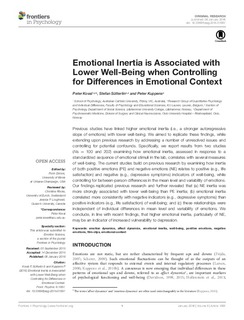| dc.description.abstract | Previous studies have linked higher emotional inertia (i.e., a stronger autoregressive slope of emotions) with lower well-being. We aimed to replicate these findings, while extending upon previous research by addressing a number of unresolved issues and controlling for potential confounds. Specifically, we report results from two studies (Ns = 100 and 202) examining how emotional inertia, assessed in response to a standardized sequence of emotional stimuli in the lab, correlates with several measures of well-being. The current studies build on previous research by examining how inertia of both positive emotions (PE) and negative emotions (NE) relates to positive (e.g., life satisfaction) and negative (e.g., depressive symptoms) indicators of well-being, while controlling for between-person differences in the mean level and variability of emotions. Our findings replicated previous research and further revealed that (a) NE inertia was more strongly associated with lower well-being than PE inertia; (b) emotional inertia correlated more consistently with negative indicators (e.g., depressive symptoms) than positive indicators (e.g., life satisfaction) of well-being; and (c) these relationships were independent of individual differences in mean level and variability of emotions. We conclude, in line with recent findings, that higher emotional inertia, particularly of NE, may be an indicator of increased vulnerability to depression. | nb_NO |

